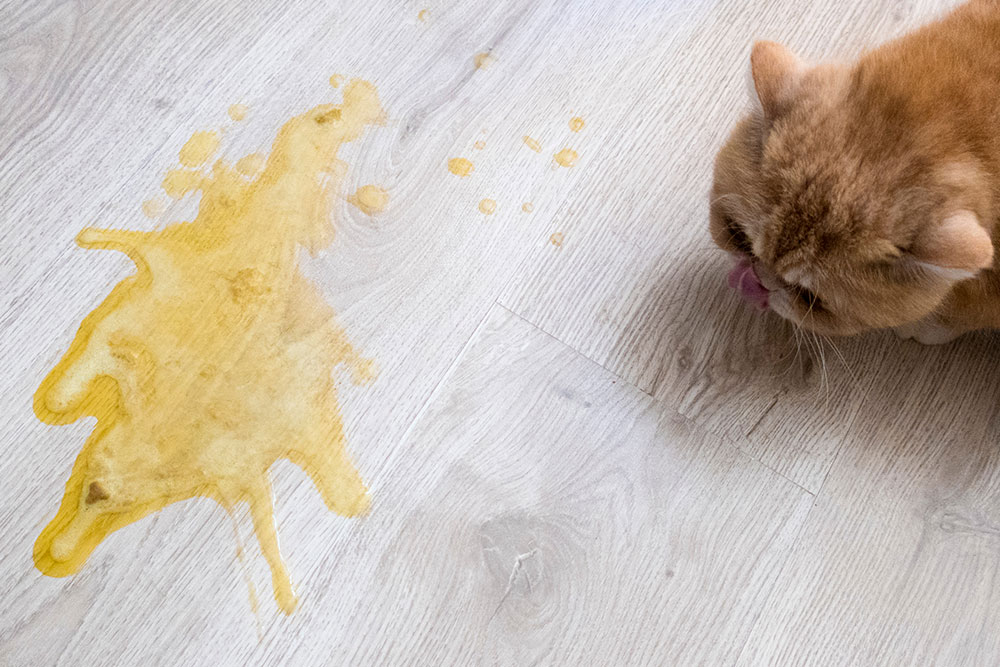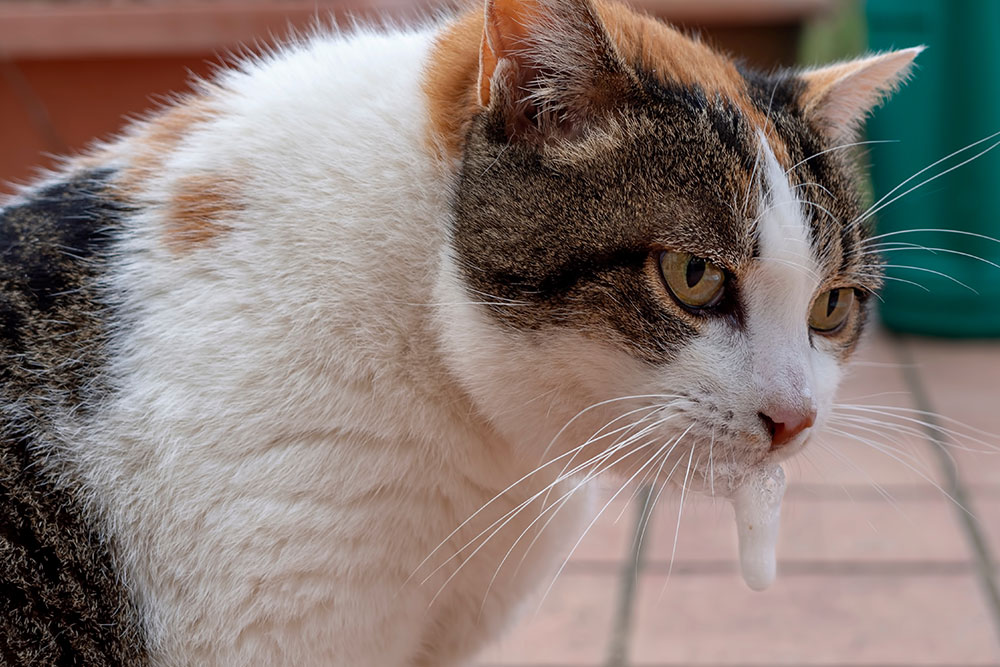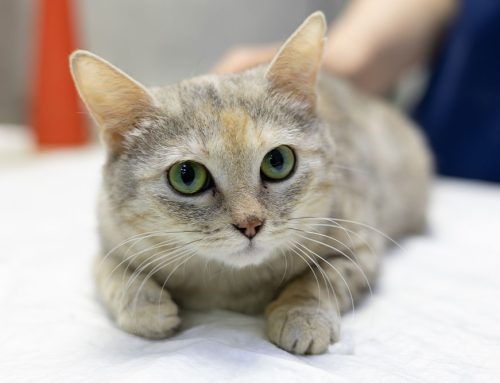At The Vale Veterinary Group, we know that watching your cat vomit—whether once or repeatedly—can be alarming. It’s one of the most common reasons cat owners call or visit us, often unsure whether they’re overreacting or not reacting enough.
Here’s the truth: vomiting in cats isn’t “normal.” Even when it’s something seemingly minor like a hairball, vomiting is a symptom—sometimes of something harmless, but potentially of something more serious. Knowing how to interpret this symptom can help you act quickly and confidently to protect your cat’s health.
What Is Vomiting—and How Is It Different From Regurgitation?
Vomiting is an active process, involving nausea, retching, and forceful ejection of stomach contents. This is different from regurgitation, which is more passive and often happens shortly after eating, without the same level of effort.
Because vomiting is triggered by irritation, inflammation, or illness within the digestive system, it’s always worth paying attention to—especially when it becomes frequent or is accompanied by other symptoms. For a clinical overview, Cornell Feline Health Center offers further details.
Common Causes of Vomiting in Cats
There are many reasons cats vomit, ranging from minor to life-threatening. Here are some of the most common culprits:
1. Hairballs
Cats groom themselves meticulously, and loose hair can accumulate in the stomach. While occasional hairballs are manageable, frequent ones may indicate overgrooming, dietary fibre imbalance, or digestive tract issues.
2. Diet-Related Issues
Rapid eating, sudden diet changes, food allergies, or eating something unsuitable (like spoiled food or human snacks) can all cause vomiting. For guidance on feeding safety, see Pet Food Safety – CDC.
3. Parasites
Worms and other intestinal parasites can irritate the digestive tract. Regular deworming and faecal exams are essential preventative steps.
4. Infections
Cats with viral or bacterial infections often present with vomiting, especially younger or outdoor cats.
5. Chronic Conditions
Vomiting may be an early warning sign of more serious illnesses, including:
- Chronic Kidney Disease
(Chronic Kidney Disease in Cats – Cornell) - Hyperthyroidism
(AAHA Guidelines for Feline Hyperthyroidism) - Pancreatitis or Inflammatory Bowel Disease (IBD)
- Liver disease
6. Foreign Objects
If your cat has ingested something it shouldn’t—like string, rubber bands, or tinsel—it may result in a blockage. These are often emergencies. Read more at ACVS: Gastrointestinal Foreign Bodies.
Why It’s Important Not to Ignore Vomiting
Even when your cat seems fine between episodes, repeated vomiting can lead to:
- Dehydration
- Nutritional deficiencies
- Weight loss
- Esophageal damage
- Progression of undiagnosed disease
The bottom line? Chronic vomiting is your cat’s way of saying something’s not right. Delaying care may result in more complex problems—and more intensive treatment later on.
Warning Signs That Warrant a Vet Visit
Monitor not just the vomiting itself, but any patterns or accompanying behaviours. Pay attention to:
- Frequency: More than twice in a week is concerning.
- Appearance: Blood, bile, worms, or anything unusual. Use this guide to identify vomit types – Purina
- Additional Symptoms:
- Lethargy (Recognising Lethargy in Cats)
- Loss of appetite
- Hiding or irritability
- Weight loss
- Diarrhoea or constipation
Diagnosis: What to Expect at The Vale Veterinary Group
If you bring your cat in for vomiting, we’ll start with a thorough history and physical examination. We may recommend:
- Blood tests (kidney, liver, thyroid)
- Urinalysis
- Stool sample analysis
- X-rays or ultrasound to rule out blockages or abnormalities
- Endoscopy or biopsy if chronic or inflammatory conditions are suspected
Each case is different, and your vet will tailor diagnostics to suit your cat’s individual history and signs.
Treatment Options
Depending on the cause, your cat’s treatment plan may include:
Mild to Moderate Cases
- Bland diet or prescription food
- Anti-nausea or antacid medication
- Deworming or probiotics
- Hairball control via grooming or supplements
Severe or Ongoing Cases
- IV fluids to combat dehydration
- Anti-inflammatory or antibiotic medication
- Hormonal treatment (e.g. for hyperthyroidism)
- Surgery if a foreign body or tumour is involved
(Explore what surgery might involve – PetCoach)
Prevention Tips
You can take several steps at home to reduce the likelihood of vomiting:
- Feed high-quality, easily digestible food
- Transition slowly when changing diets
- Brush your cat regularly
- Use puzzle or slow-feed bowls
- Provide clean, fresh water at all times
- Keep toxic plants and objects out of reach
(Check the ASPCA’s list of toxic plants)
What to Do When Vomiting Happens
If your cat vomits but is otherwise behaving normally:
- Withhold food for 12 hours, then offer a bland meal
- Keep your cat calm and comfortable
- Offer small sips of water
- Monitor stool, appetite, and behaviour over the next 24 hours
If vomiting continues or is accompanied by other symptoms, it’s time to contact us.
Preparing for Your Appointment
Bring with you:
- A vomit sample or clear photo
- A list of current foods, supplements, and medications
- A timeline of vomiting episodes
- Any photos or videos of the behaviour
Consider asking:
- What’s the likely cause?
- What tests are necessary?
- What are the treatment options and risks?
- How can I support my cat’s recovery at home?
FAQs: Vomiting in Cats
Is hairball vomiting normal?
Occasional hairballs are expected, but frequent vomiting is not. Speak with your vet if it’s happening regularly.
Can stress cause vomiting?
Yes, stress-related grooming or dietary changes can lead to vomiting.
When is vomiting an emergency?
Repeated vomiting in a short time, blood in vomit, or refusal to eat or drink are all signs to seek urgent care.
Support You Can Trust
At The Vale Veterinary Group, we know your cat is part of your family. That’s why we approach every case with care, clarity, and compassion. Whether it’s a one-off episode or something ongoing, we’re here to help you find answers—and relief—for both you and your cat.
If you’re unsure whether your cat’s vomiting is cause for concern, don’t wait. Get in touch with our team today to schedule an appointment or ask a question. We’re here to support you every step of the way.








Leave A Comment